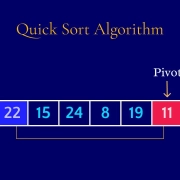A Comprehensive Guide to Merge Sort and Quick Sort Algorithms
Sorting is a fundamental operation in computer science that involves arranging elements in a specific order, often in ascending or descending order. Two popular sorting algorithms are Merge Sort and Quick Sort. These algorithms offer efficient solutions to the sorting problem and are widely used in various applications. In this article, we will delve into the details of Merge Sort and Quick Sort, explore their implementations through code examples, and compare their strengths and weaknesses.
Merge Sort
Merge Sort is a divide-and-conquer algorithm that divides an array into two halves, recursively sorts each half, and then merges the sorted halves back together. The key insight of Merge Sort is that it’s easier to merge two sorted arrays into a single sorted array than to directly sort an unsorted array.
Implementation
Here’s a step-by-step breakdown of the Merge Sort algorithm in Python:
def merge_sort(arr):
if len(arr) <= 1:
return arr
# Divide the array into two halves
mid = len(arr) // 2
left_half = arr[:mid]
right_half = arr[mid:]
# Recursively sort each half
left_half = merge_sort(left_half)
right_half = merge_sort(right_half)
# Merge the sorted halves
return merge(left_half, right_half)
def merge(left, right):
result = []
i = j = 0
while i < len(left) and j < len(right):
if left[i] < right[j]:
result.append(left[i])
i += 1
else:
result.append(right[j])
j += 1
result.extend(left[i:])
result.extend(right[j:])
return result
Complexity Analysis
- Time Complexity: Merge Sort has a time complexity of O(n log n) in the worst, average, and best cases. This makes it highly efficient for sorting large datasets.
- Space Complexity: Merge Sort has a space complexity of O(n) due to the need for temporary storage during the merge step.
Quick Sort
Quick Sort is another efficient divide-and-conquer sorting algorithm. It works by selecting a ‘pivot’ element and partitioning the array into two sub-arrays – elements less than the pivot and elements greater than the pivot. The sub-arrays are then recursively sorted. The key to the efficiency of Quick Sort is choosing a good pivot that evenly divides the array.
Implementation
Here’s a step-by-step breakdown of the Quick Sort algorithm in Python:
def quick_sort(arr):
if len(arr) <= 1:
return arr
pivot = arr[len(arr) // 2]
left = [x for x in arr if x < pivot]
middle = [x for x in arr if x == pivot]
right = [x for x in arr if x > pivot]
return quick_sort(left) + middle + quick_sort(right)
Quick Sort can also be implemented in-place, which reduces the space complexity but requires more complex partitioning logic. Below is an in-place version:
def quick_sort_in_place(arr, low, high):
if low < high:
pivot_index = partition(arr, low, high)
quick_sort_in_place(arr, low, pivot_index)
quick_sort_in_place(arr, pivot_index + 1, high)
def partition(arr, low, high):
pivot = arr[low]
left = low + 1
right = high
done = False
while not done:
while left <= right and arr[left] <= pivot:
left = left + 1
while arr[right] >= pivot and right >= left:
right = right -1
if right < left:
done= True
else:
arr[left], arr[right] = arr[right], arr[left]
arr[low], arr[right] = arr[right], arr[low]
return right
Complexity Analysis
- Time Complexity: Quick Sort has an average-case time complexity of O(n log n), but in the worst case, it can degrade to O(n^2) if the pivot selection is consistently poor. However, randomized pivot selection or using a middle element as the pivot often mitigates this issue.
- Space Complexity: Quick Sort generally has a space complexity of O(log n) due to its recursive nature. The in-place version further reduces the space complexity.
Comparison
Both Merge Sort and Quick Sort have their own advantages and disadvantages:
- Stability: Merge Sort is a stable sorting algorithm, which means that equal elements retain their relative order after sorting. Quick Sort, when implemented with standard partitioning schemes, is not stable.
- Space Complexity: Merge Sort has a higher space complexity due to the need for additional storage during the merge step. Quick Sort is more memory-efficient, especially the in-place version.
- Performance: Merge Sort performs consistently well regardless of the input data distribution, making it a reliable choice. Quick Sort’s performance heavily relies on the pivot selection, and its worst-case behavior can be problematic for certain inputs.
- Use Cases: Merge Sort is often used in external sorting scenarios where data doesn’t fit entirely in memory. Quick Sort is commonly used in practice when average-case performance matters more than worst-case performance.
Conclusion
Merge Sort and Quick Sort are two powerful sorting algorithms with different strengths and weaknesses. Merge Sort’s consistent performance and stability make it a reliable choice for various scenarios, while Quick Sort’s average-case efficiency and low memory usage make it a popular choice for in-memory sorting tasks. Understanding these algorithms and their implementations is essential for any programmer dealing with sorting tasks, as they provide efficient solutions to a fundamental problem in computer science.






